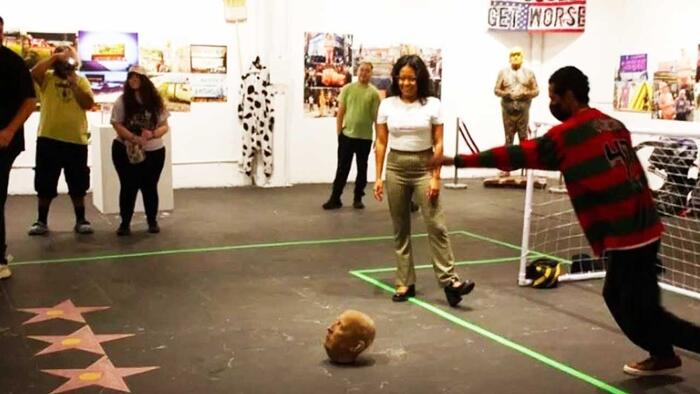An art exhibit in Los Angeles has recently garnered attention for its provocative approach to political dissent, featuring a soccer ball styled to look like former President Donald Trump’s head. This installation, created by the art collective INDECLINE, allowed participants at the Superchief Gallery to kick around what resembled a rubber or latex version of Trump’s likeness, ostensibly as a commentary against his purported role in “spreading hate.” The event was not the first of its kind; the group had previously showcased the Trump soccer ball at the Mexican border four years prior, highlighting an ongoing thematic engagement with political figures through controversial artistic expression.
The rationale behind the exhibit, according to the organizers, was to embody a form of playful protest against the former president’s politics. INDECLINE described “Freedom Kick” as a metaphorical match depicting a conflict over American values, suggesting that their work aims to challenge the current political climate. They claimed the event was an appropriate display of opposition to what they view as Trump’s divisive rhetoric. However, critics, including some social media users, have labeled this display as hypocritical, questioning how dehumanizing a symbolic representation of a decapitated head aligns with the message of opposing hate.
Notably, the juxtaposition of this soccer ball exhibit with another display featuring a statue of a naked Trump with exaggeratedly mutilated genitals at Subliminal Projects Gallery further emphasizes a trend of extreme political satire among contemporary artists. This ongoing artistic critique reflects broader societal tensions and showcases a specific approach within leftist spheres to express anger and discontent toward Trump’s legacy and political stance. The presence of such artworks indicates an intense engagement with art as a means of activism, though it is often met with backlash from various constituencies.
Adding to the conversation around this art display, the timing coincides with recent incidents involving threats against Trump, including attempted assassinations by individuals described as leftist extremists. This divergence raises questions about the implications of artistic protests and the extent to which they can provoke real-world actions. The art collective’s motivations are framed as a means of opposing hate, yet instances of violence against Trump highlight the dangerous intersection of political rhetoric and artistic expression.
Responses to the exhibition emphasize the cognitive dissonance many feel toward artistic freedom and the potential normalization of violence in political discourse. Critics argue that such exhibitions may inadvertently condone radical actions by trivializing the human form through artistic degradation, while proponents see them as necessary measures of expression in troubled political times. The debate illuminates a broader struggle regarding the acceptable limits of protest and the role of art in contemporary political dialogues.
Ultimately, the Los Angeles art exhibit serves as a microcosm of the polarized environment surrounding political figures like Trump, illustrating the contentious nature of artistic expression as a mode of dissent. As politics and art continue to intertwine, the implications of such exhibitions may reverberate beyond galleries and into the public consciousness, shaping how we engage with political figures and the issues that divide us.

